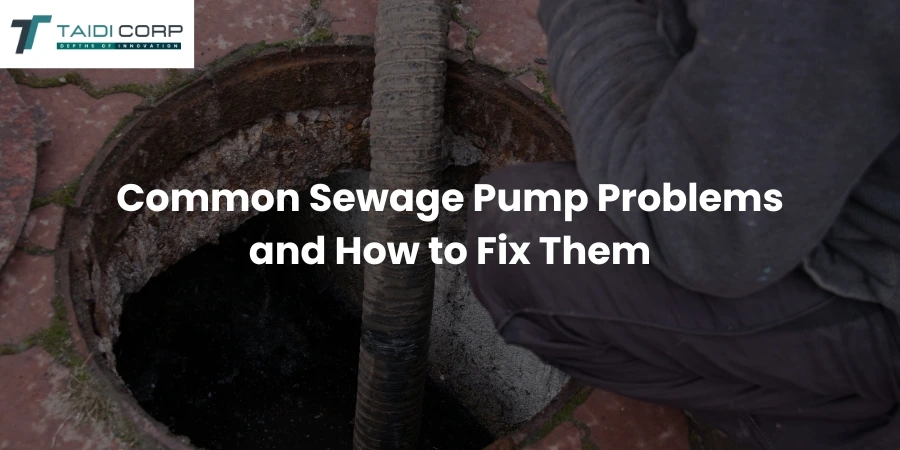
Maintaining a well-functioning sewage pump is essential for effective waste management in any property. Whether you’re a homeowner, property manager, DIY enthusiast, or a plumbing professional, understanding common sewage pump problems and their solutions can save you time, money, and prevent potential health hazards. This comprehensive guide will help you identify, prevent, and fix common issues with sewage pump systems, ensuring they operate efficiently and reliably.
Importance of a Well-Functioning Sewage Pump
The Role of Sewage Pumps in Waste Management
Sewage pumps play a crucial role in transporting wastewater from lower elevations, such as basements, to higher elevations like sewer lines or septic tanks. A malfunctioning sewage pump can lead to sewage backups, unpleasant odors, and potential property damage. Addressing pump issues promptly ensures the smooth operation of your waste management system and maintains a healthy living environment.
Purpose of the Guide
This guide aims to educate you on identifying common sewage pump issues and provide clear, actionable steps to fix them. Whether you’re handling minor repairs yourself or seeking professional assistance, this information will help you maintain your sewage pump effectively.
How Sewage Pumps Work: A Quick Overview
Basic Components
Understanding the basic components of a sewage pump can help you troubleshoot problems more effectively. The main parts include:
- Motor: Powers the pump.
- Impeller: Moves wastewater through the pump.
- Float Switch: Activates the pump when water reaches a certain level.
- Check Valve: Prevents wastewater from flowing back into the basin.
- Discharge Pipe: Carries wastewater away from the pump.
How the Pump Operates
A sewage pump operates by using the motor to drive the impeller, which pushes wastewater from the basin to the discharge pipe. The float switch detects the water level and turns the pump on or off accordingly, ensuring efficient wastewater removal.
Common Sewage Pump Problems and Their Causes
1. Pump Not Turning On
Possible Causes
- Power Issues: Tripped breakers or faulty power supply.
- Faulty Float Switch: Prevents the pump from activating.
- Motor Failure: The motor may have burned out or malfunctioned.
How to Fix
- Check the Power Supply: Ensure the pump is plugged in and the outlet is functioning.
- Reset the Breaker: Locate your electrical panel and reset any tripped breakers.
- Test the Float Switch: Verify if the float switch moves freely and triggers the pump.
- Inspect Motor Connections: Ensure all electrical connections to the motor are secure.
Visual Aid: Diagram showing the electrical connections and float switch location.
2. Pump Running Continuously
Possible Causes
- Stuck Float Switch: The float switch may be jammed in the “on” position.
- Clogged Discharge Line: Obstructions can prevent proper drainage.
- Defective Check Valve: Allows wastewater to flow back into the basin.
How to Fix
- Adjust or Replace the Float Switch: Ensure it moves freely and isn’t obstructed.
- Clean the Discharge Pipe: Remove any blockages to restore proper flow.
- Check the Check Valve: Replace if it’s not functioning correctly.
Visual Aid: Step-by-step images for adjusting the float switch and cleaning the discharge pipe.
3. Slow or No Drainage
Possible Causes
- Clogged Impeller: Debris can hinder the impeller’s functionality.
- Blocked Discharge Pipe: Obstructions slow down or stop wastewater flow.
- Undersized Pump: The pump may not have enough capacity for the wastewater volume.
How to Fix
- Clean or Replace the Impeller: Remove debris and ensure the impeller spins freely.
- Clear the Discharge Line: Use a pipe cleaner to remove any blockages.
- Ensure Proper Pump Sizing: Verify that your pump is appropriately sized for your needs.
Visual Aid: Diagram showing the impeller and discharge pipe.
4. Unusual Noises (Grinding, Rattling, or Humming)
Possible Causes
- Debris in the Impeller: Foreign objects can cause noise and damage.
- Worn Bearings: Bearings may need lubrication or replacement.
- Loose Motor: Vibrations can loosen the motor, causing rattling.
How to Fix
- Disconnect the Pump and Clean the Impeller: Remove any debris causing noise.
- Inspect and Lubricate Bearings: Ensure bearings are in good condition and properly lubricated.
- Secure Loose Components: Tighten any loose parts to eliminate rattling.
Visual Aid: Images showing how to clean the impeller and inspect bearings.
5. Frequent Short Cycling
Possible Causes
- Incorrect Float Switch Height: May cause the pump to turn on and off too frequently.
- Small Sump Basin: Limited capacity can lead to rapid cycling.
- Inappropriate Pump Size: A pump that’s too powerful for the system.
How to Fix
- Adjust the Float Switch Position: Set it to activate at appropriate water levels.
- Consider a Larger Basin: Increase the basin size to reduce cycling frequency.
- Select a Suitable Pump: Ensure the pump’s capacity matches your system’s requirements.
Visual Aid: Flowchart for adjusting float switch height based on symptoms.
6. Foul Odors Around the Pump
Possible Causes
- Leaking Seals: Allow wastewater to escape and cause odors.
- Improper Venting: Poor ventilation can trap smells.
- Buildup of Waste and Bacteria: Accumulated waste can produce unpleasant odors.
How to Fix
- Inspect and Replace Worn Seals: Ensure all seals are intact to prevent leaks.
- Check for Proper Venting: Ensure vents are not blocked and are functioning correctly.
- Clean the Pump Basin Thoroughly: Remove any sludge or debris buildup.
Visual Aid: Diagram showing proper sealing and venting of the pump basin.
7. Pump Overheating or Tripping Breakers
Possible Causes
- Electrical Issues: Faulty wiring or connections.
- Inadequate Pump Ventilation: Overheating due to poor airflow.
- Failing Motor: Motor issues can cause excessive heat.
How to Fix
- Check Electrical Connections: Ensure all wiring is secure and free from damage.
- Ensure Proper Ventilation: Improve airflow around the pump to prevent overheating.
- Test the Motor for Damage: Replace the motor if it’s overheating or malfunctioning.
Visual Aid: Images illustrating proper ventilation around the pump.
8. Backflow or Reflux into the Basin
Possible Causes
- Faulty or Missing Check Valve: Allows wastewater to flow back into the basin.
How to Fix
- Install or Replace the Check Valve: Ensure it effectively prevents backflow.
Visual Aid: Diagram showing the installation of a check valve.
Step-by-Step Troubleshooting Guide
Basic Tools Needed
- Wrench set
- Screwdriver
- Voltmeter
- Pipe cleaner
- Lubricant
Visual Inspection
- Check for Visible Damage: Look for cracks, leaks, or broken parts.
- Inspect for Leaks: Ensure all connections are watertight.
- Look for Loose Connections: Tighten any loose bolts or fittings.
Testing Electrical Components
- Safely Test the Power Supply: Use a voltmeter to ensure the pump is receiving power.
- Test the Float Switch: Verify its functionality with a voltmeter.
- Check the Motor: Ensure the motor is operating correctly without any electrical issues.
Cleaning and Clearing Blockages
- Remove Debris from the Impeller: Clean out any obstructions.
- Clear the Discharge Line: Use a pipe cleaner to remove blockages.
- Clean the Basin: Remove sludge and debris buildup to ensure smooth operation.
Visual Aid: Flowchart for troubleshooting based on symptoms.
Preventative Maintenance Tips to Avoid Future Problems
Regular Inspections
- Schedule Monthly Checks: Regularly inspect your sewage pump to catch early signs of wear or damage.
Proper Use
- Avoid Flushing Non-Biodegradable Items: Do not flush wipes, diapers, or feminine hygiene products that can clog the system.
Clean the Basin
- Periodically Clean the Pump Basin: Prevent sludge and debris buildup by cleaning the basin regularly.
Check the Float Switch
- Ensure the Float Switch Moves Freely: Remove any obstructions that may hinder its movement.
When to Call a Professional
Complex Electrical Issues
- Pump Tripping Breakers or Motor Not Responding: Seek professional help for electrical repairs.
Persistent or Recurring Problems
- Issues Persist After Basic Troubleshooting: A professional can diagnose and fix underlying problems.
Pump Replacement
- Pump Nearing End of Lifespan: Replace the pump if it’s over 7-10 years old or has significant mechanical damage.
Choosing the Right Replacement Parts or Pump
Factors to Consider
- Capacity: Ensure the pump can handle your wastewater volume.
- Durability: Choose materials that resist corrosion and wear.
- Brand Reputation: Opt for reliable brands with good reviews.
- Warranty: Select pumps with comprehensive warranties for peace of mind.
Recommended Brands and Models
- Submersible Pumps: Zoeller M53, Liberty Pumps 257
- Pedestal Pumps: Zoeller M98, Liberty Pumps 257Z
- Grinder Pumps: Liberty Pumps HGR-50, Zoeller GP727
FAQs
How long should a sewage pump last?
A sewage pump typically lasts between 7-10 years with proper maintenance.
What size pump do I need for my home?
Pump size depends on the volume of wastewater and the height it needs to pump. Consult a professional to determine the appropriate size for your needs.
Can I install a sewage pump myself?
While basic installation is possible for those with plumbing knowledge, complex installations and electrical connections are best handled by professionals.
What is the difference between a sewage pump and a sump pump?
Sewage pumps handle wastewater containing solids, while sump pumps are designed for removing groundwater and preventing basement flooding.
Conclusion
Maintaining a well-functioning sewage pump is essential for efficient waste management and preventing costly repairs or property damage. By understanding common sewage pump problems and knowing how to fix them, you can ensure your system operates smoothly and reliably. Regular maintenance and prompt attention to issues will extend the lifespan of your pump and maintain a healthy environment in your home or property.
Have you encountered any sewage pump issues? Share your experiences or ask questions in the comments below! For more detailed guides or professional assistance, click here to explore additional resources.
